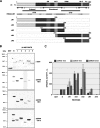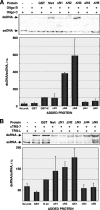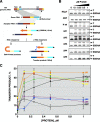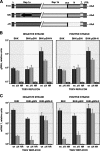Coronavirus nucleocapsid protein facilitates template switching and is required for efficient transcription
- PMID: 19955314
- PMCID: PMC2812394
- DOI: 10.1128/JVI.02011-09
Coronavirus nucleocapsid protein facilitates template switching and is required for efficient transcription
Abstract
Purified nucleocapsid protein (N protein) from transmissible gastroenteritis virus (TGEV) enhanced hammerhead ribozyme self-cleavage and favored nucleic acid annealing, properties that define RNA chaperones, as previously reported. Several TGEV N-protein deletion mutants were expressed in Escherichia coli and purified, and their RNA binding ability and RNA chaperone activity were evaluated. The smallest N-protein domain analyzed with RNA chaperone activity, facilitating DNA and RNA annealing, contained the central unstructured region (amino acids 117 to 268). Interestingly, N protein and its deletion mutants with RNA chaperone activity enhanced template switching in a retrovirus-derived heterologous system, reinforcing the concept that TGEV N protein is an RNA chaperone that could be involved in template switching. This result is in agreement with the observation that in vivo, N protein is not necessary for TGEV replication, but it is required for efficient transcription.
Figures




Similar articles
-
Coronavirus nucleocapsid protein is an RNA chaperone.Virology. 2007 Jan 20;357(2):215-27. doi: 10.1016/j.virol.2006.07.046. Epub 2006 Sep 18. Virology. 2007. PMID: 16979208 Free PMC article.
-
Functional interactions of nucleocapsid protein of feline immunodeficiency virus and cellular prion protein with the viral RNA.J Mol Biol. 2002 Apr 19;318(1):149-59. doi: 10.1016/S0022-2836(02)00092-X. J Mol Biol. 2002. PMID: 12054775
-
Gene N proximal and distal RNA motifs regulate coronavirus nucleocapsid mRNA transcription.J Virol. 2011 Sep;85(17):8968-80. doi: 10.1128/JVI.00869-11. Epub 2011 Jun 29. J Virol. 2011. PMID: 21715479 Free PMC article.
-
Nucleic acid chaperone activity of HIV-1 nucleocapsid protein: critical role in reverse transcription and molecular mechanism.Prog Nucleic Acid Res Mol Biol. 2005;80:217-86. doi: 10.1016/S0079-6603(05)80006-6. Prog Nucleic Acid Res Mol Biol. 2005. PMID: 16164976 Review. No abstract available.
-
Nucleic-acid-chaperone activity of retroviral nucleocapsid proteins: significance for viral replication.Trends Biochem Sci. 1998 Aug;23(8):297-301. doi: 10.1016/s0968-0004(98)01256-0. Trends Biochem Sci. 1998. PMID: 9757830 Review.
Cited by
-
The SARS-CoV-2 Nucleocapsid phosphoprotein forms mutually exclusive condensates with RNA and the membrane-associated M protein.bioRxiv [Preprint]. 2020 Jul 31:2020.07.30.228023. doi: 10.1101/2020.07.30.228023. bioRxiv. 2020. Update in: Nat Commun. 2021 Jan 21;12(1):502. doi: 10.1038/s41467-020-20768-y. PMID: 32766587 Free PMC article. Updated. Preprint.
-
Characterization of a critical interaction between the coronavirus nucleocapsid protein and nonstructural protein 3 of the viral replicase-transcriptase complex.J Virol. 2013 Aug;87(16):9159-72. doi: 10.1128/JVI.01275-13. Epub 2013 Jun 12. J Virol. 2013. PMID: 23760243 Free PMC article.
-
Molecular characteristic, evolution, and pathogenicity analysis of avian infectious bronchitis virus isolates associated with QX type in China.Poult Sci. 2024 Dec;103(12):104256. doi: 10.1016/j.psj.2024.104256. Epub 2024 Aug 28. Poult Sci. 2024. PMID: 39288718 Free PMC article.
-
Interaction of coronavirus nucleocapsid protein with the 5'- and 3'-ends of the coronavirus genome is involved in genome circularization and negative-strand RNA synthesis.FEBS J. 2019 Aug;286(16):3222-3239. doi: 10.1111/febs.14863. Epub 2019 May 8. FEBS J. 2019. PMID: 31034708 Free PMC article.
-
Melatonin: Regulation of Viral Phase Separation and Epitranscriptomics in Post-Acute Sequelae of COVID-19.Int J Mol Sci. 2022 Jul 23;23(15):8122. doi: 10.3390/ijms23158122. Int J Mol Sci. 2022. PMID: 35897696 Free PMC article. Review.
References
Publication types
MeSH terms
Substances
LinkOut - more resources
Full Text Sources

